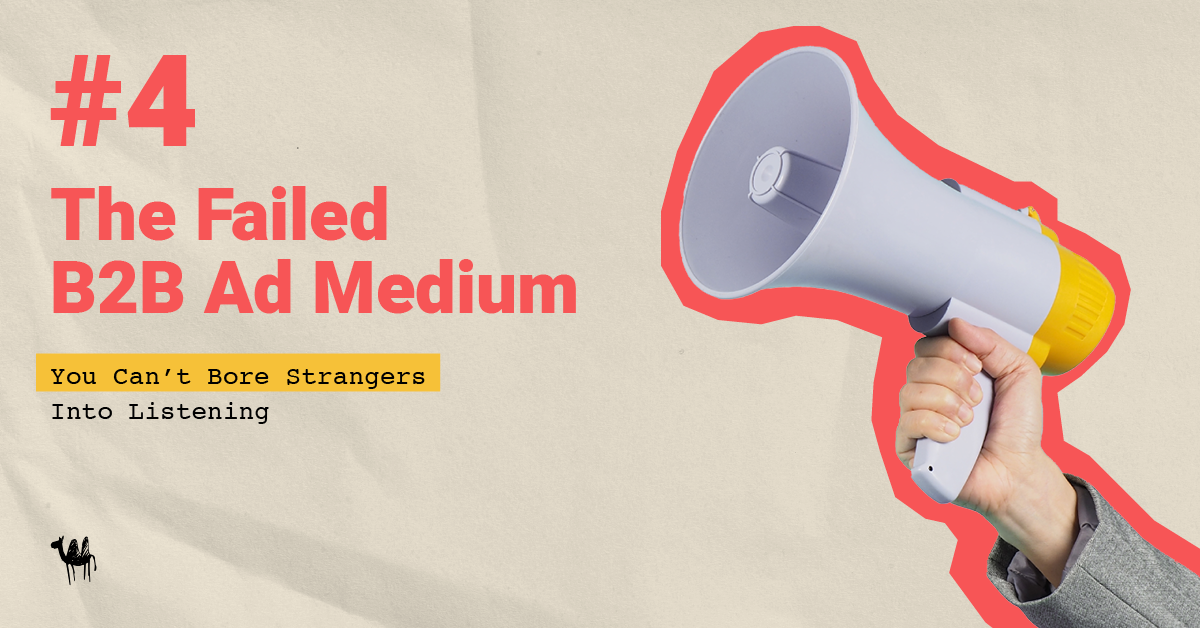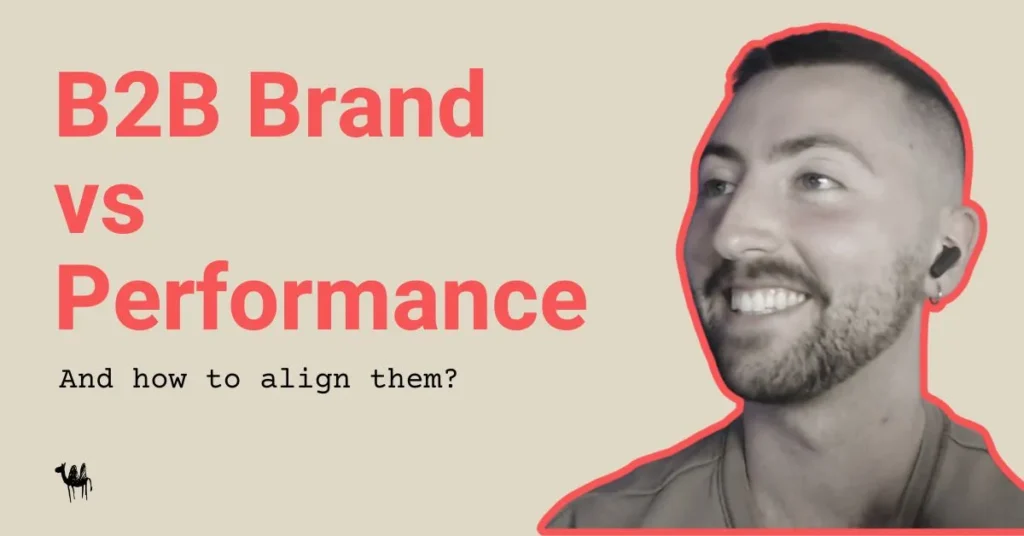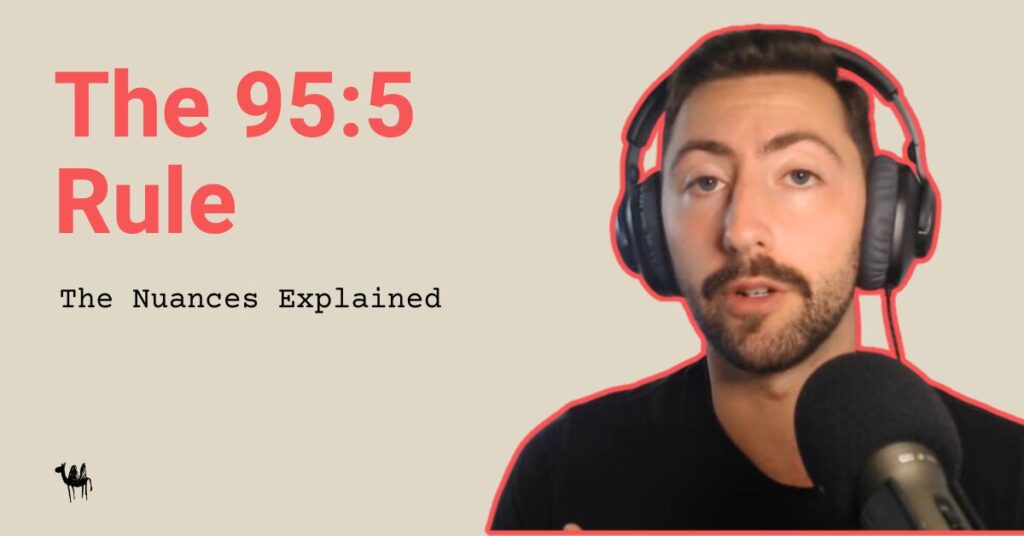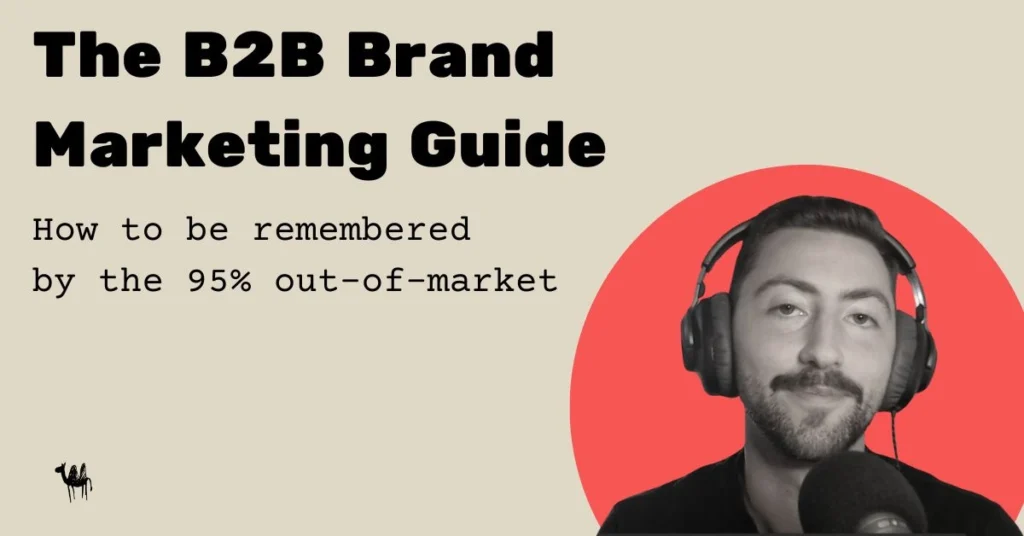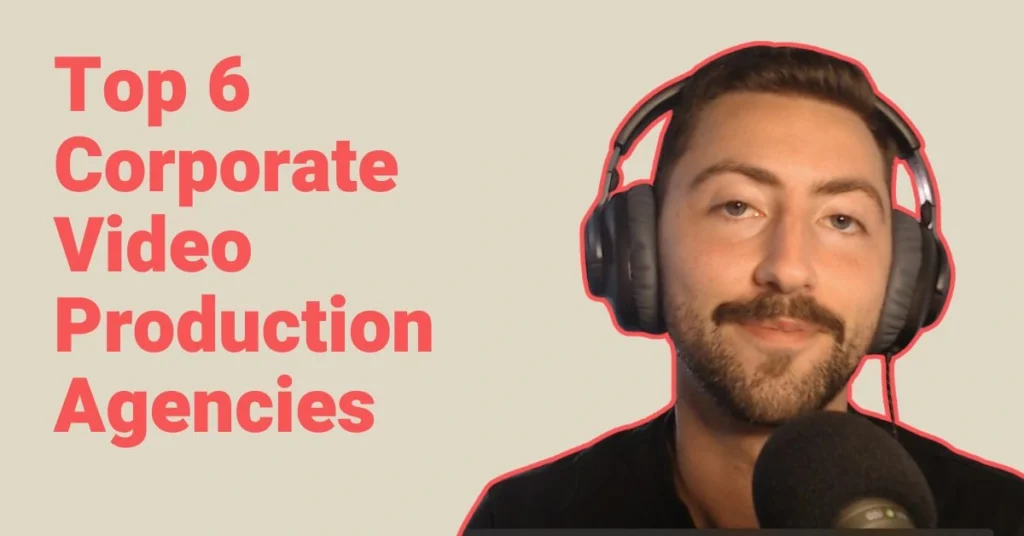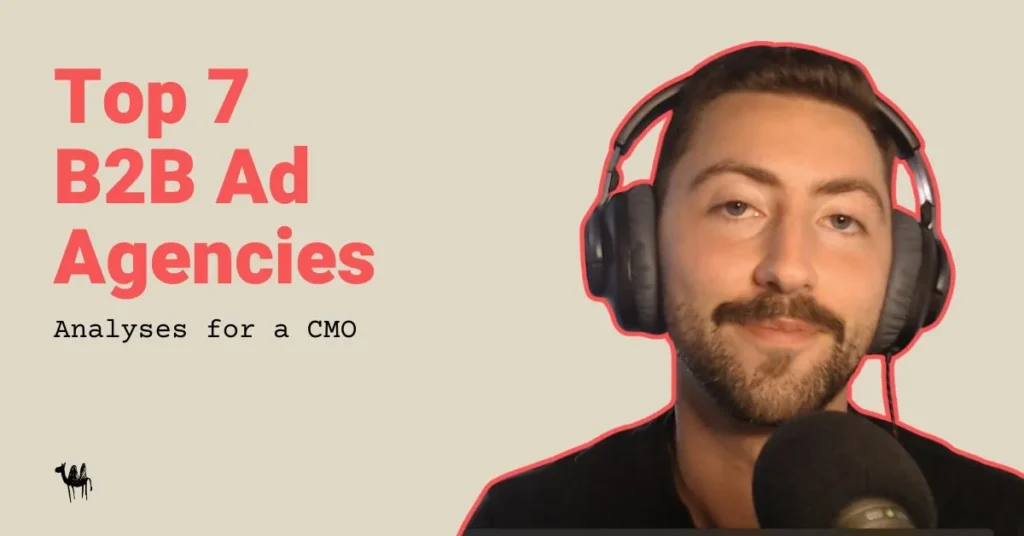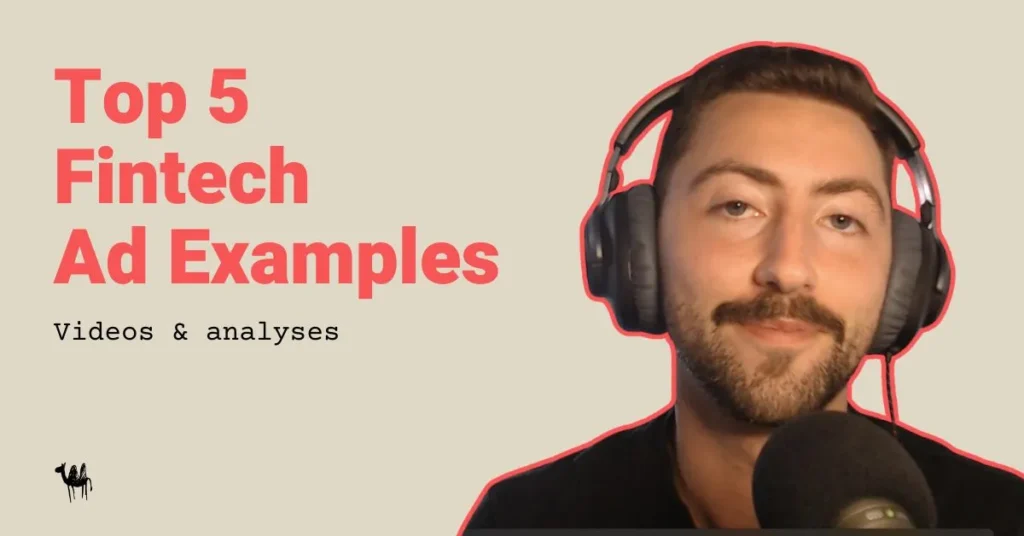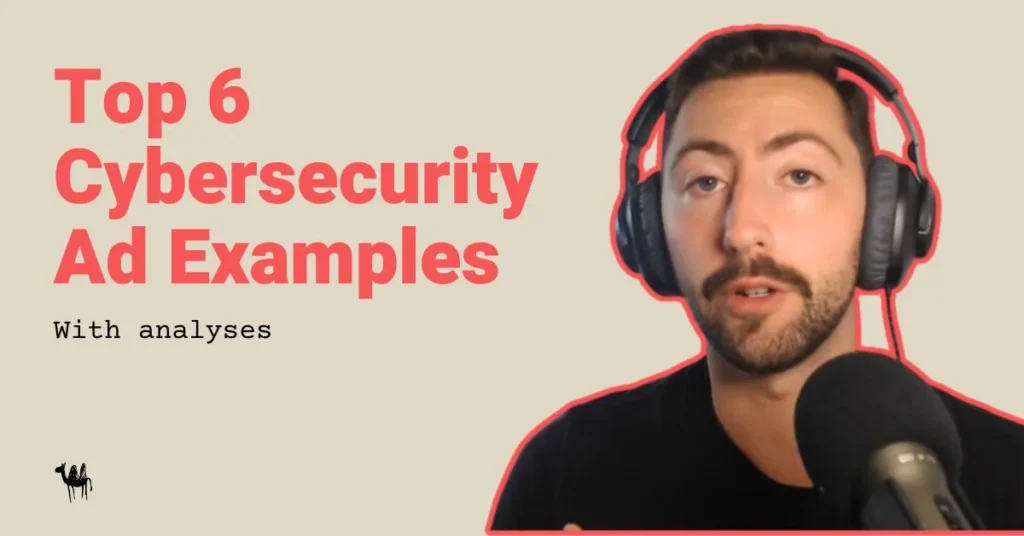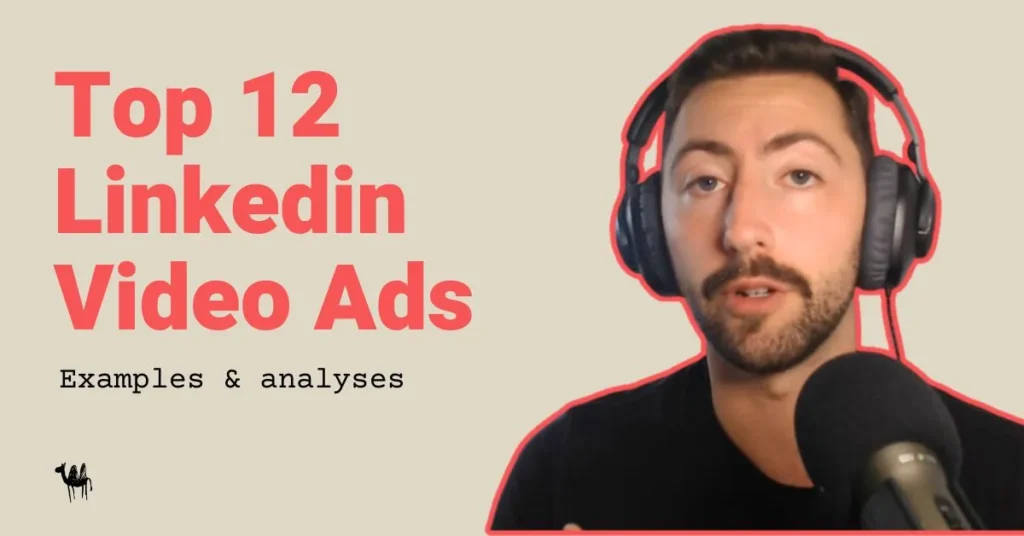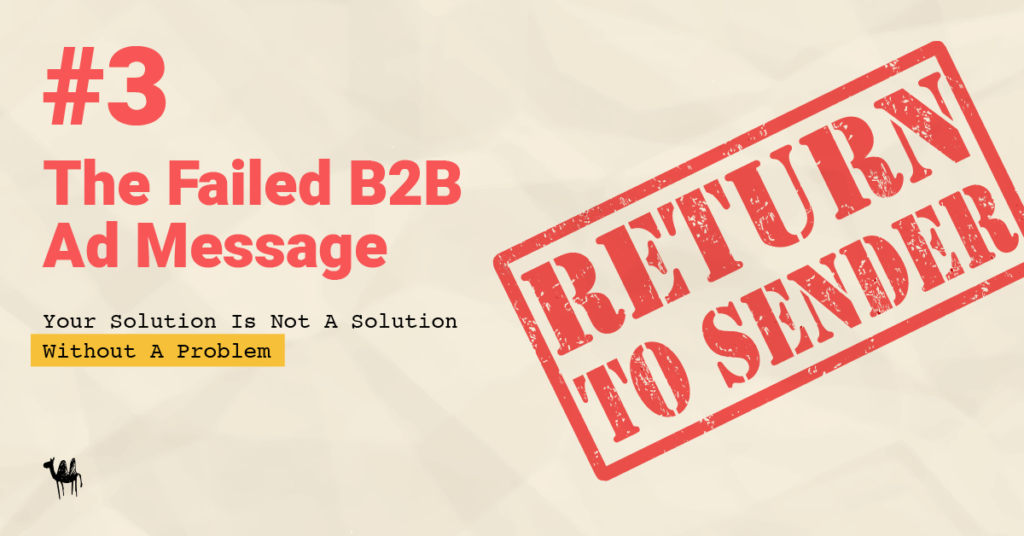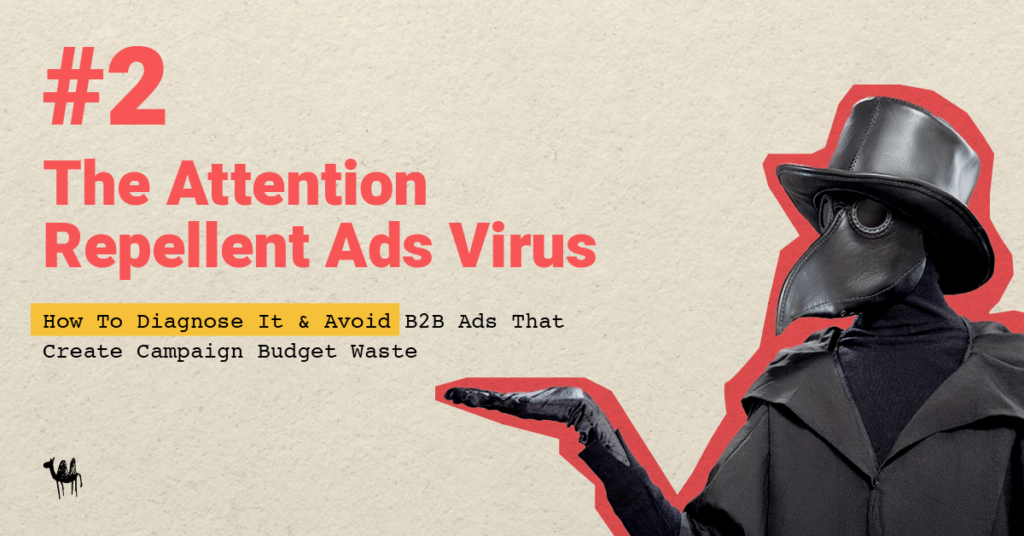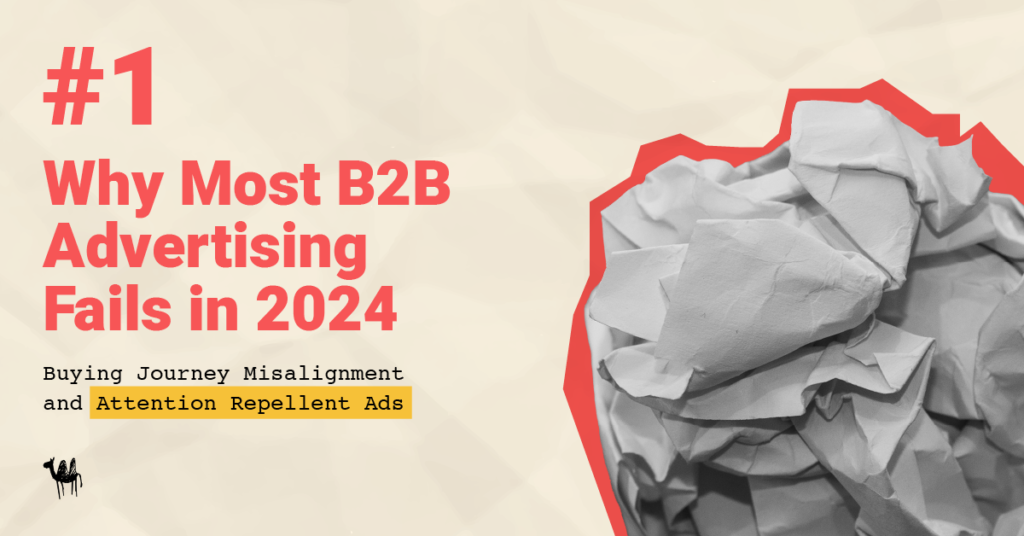Each of our Problemotional Advertising articles are written in a sequence. We strongly recommend reading them from Article 1 to the most recently published. This will ensure you understand everything you need to create a profitable and scalable B2B advertising campaign and avoid wasting hundreds of thousands of dollars.
Disclaimer: If you believe that B2B should be mind-numbingly boring and painful, you will experience extreme discomfort by reading the following article. Continue at your own risk.
Written by Dylan Ciaccio and Regan George
“You cannot bore people into buying your product; you can only interest them in buying it.” — David Ogilvy, Confessions of an Advertising Man
Dear CMO,
How can the opposite of a good idea still be a good idea in advertising?
Why does Bobathor The Caveman remember to buy a spear at CaveMart?
How can a boring service make us cry?
And most importantly, how does not knowing these answers waste your B2B ad budget?
First, let’s back up a second.
How Emotional B2B Advertising Impacts Buyer Perception
In our previous article, The Failed Ad Message: Your Solution Is Not A Solution Without A Problem, we explained how advertising is a battle for perception. The reality doesn’t matter. What creates the right (or wrong) perception is the message you put out in your advertising, from the very first interaction buyers have with you.
There are 2 possible perceptions that buyers can have of your B2B service.
- Interchangeable Nice-To-Have (caused by a solution-focused message)
- Irreplaceable Need-To-Have (caused by a problem-focused message)
The perception is what determines inbound booked calls, win rate, sales cycle length and customer acquisition costs. In other words, perception determines growth, scalability, and profitability.
But …
- You can’t create the right perception if the ad message isn’t heard or read.
- And the right perception won’t influence buying if the message isn’t remembered.
- And the influence of buying can’t be maximized if the message isn’t shared.
And what determines all of this is HOW that message is communicated.
When Dylan was learning French and living in France, he decided to text his friends only in French.
One day, he had made plans with a French friend (female) to go out later that evening to a party. Unfortunately, Dylan’s level of French wasn’t as good as he thought. He decided to send her a text message, “Je suis excité pour ce soir.”
The message he was trying to say was an innocent, “I’m excited for tonight.” But because of how he said it (using the wrong word), she understood, “I’m horny for tonight.”
Oops. Message not received well. #blocked

If you don’t communicate the message you want to put out in the right way, then it doesn’t work the way you want it to.
In other words…
The right message can’t work without the right medium.
In this article, we’ll break down 3 key outcomes and how they’re achieved by communicating your ad message in an emotional way (aka the medium) instead of rationally like most B2B ads.
Outcome 1: Your ads about the problem-focused message are heard/read
Outcome 2: Buyers remember you as the Irreplaceable Need-To-Have solution to the problem when buyers are ready to buy
Outcome 3: Your ad viewers share the ad with other people that suffer from the problem (WOM is and will always be the number 1 driver of growth)
First, we need to understand decision-making functions in the buying journey. When we try to communicate using the wrong decision-making function in mind, the message is not received effectively.
How Emotional B2B Ads Fit In The B2B Buying Journey
We call this B2B Buying Journey Misalignment. It’s the reason most B2B ads are wasting budget and triggering CFO tantrums.
Buying Journey Alignment considers both the stage of awareness but also how decisions are made. The previous article focused on the stages of awareness (problem vs solution). This article is about decision-making.
On Linkedin, there are 2 factions waging war against each other, laying waste to the Linkedin feed we hold so near and dear to our hearts.
Each believes they know how B2B buyers receive messages and make decisions: rationally vs emotionally.
We call it the B2B Marketing Communication War.
Faction leaders drop heated comments onto each other’s posts, conduct drive-by DMs, and partake in public shaming via memes. Bystanding, Linkedin citizens are no longer able to have peaceful conversations about their weekend plans and kids’ soccer games without being disrupted by the raging Guerilla Comment Warfare.
One faction, the United Rational Alliance (URA), is composed of traditionalists that champion the need to communicate rationally in B2B. They believe emotions are for impulsive B2C decisions, not $100k deals and that complex purchases with high stakes demand logic.
The URA are a quieter people compared to their counterparts. But do not be mistaken by their lack of noise, their presence is numerous in B2B marketing.
The opposing faction, the Democratic Emotional Revolutionaries (DER), is composed of progressives that have rebelled against the URA’s long-standing rule over B2B marketing. For years, they hid in the shadows of the outer territories – Reddit, TikTok, Endor – slowly converting new followers to their cause (primarily dopamine-addicted Gen Z). And only recently they have gained enough tiktok-dancing followers to launch a coup.
So, who is right? Should B2B marketing be rational or emotional? Which ideology drives more revenue?
Well, dear marketing reader, we have forgotten to mention that there exists an alternative faction: the Black Camel Peace Corps.
We’ve created a third faction to unite both ideologies, ensuring LinkedIn harmony and profitable B2B campaigns. Consider this counterintuitive idea.
The opposite of a good idea can also be a good idea.
Both factions believe B2B buying is either emotional or rational, mutually exclusive. But by analyzing their commentary, we’ve found the hidden piece of the puzzle: they’re both right and both wrong. How can that be?
The emotional faction makes claims like:
- “You can’t get attention when you’re boring.”
- “Emotion creates an attachment to the brand and helps people remember it when they’re ready to buy.”
- “Emotion is what inspires people to take action and learn more.”
The rational faction makes claims like:
- “When someone thinks about buying a $500k service, they are thinking about the ins and outs of it for months. That’s deep and rational thinking.”
- “When someone thinks about buying such a complex service, they need to trust that they are experts. They need information and cold-hard facts.”
- “When someone thinks about buying, they need to measure the value against the costs.”
While these are all very different claims, they’re both right. One is making claims about apples and the other about oranges.
They’re talking about decision making at different moments in the buying journey.
B2B decision making in the buying journey is both emotional and rational, it just depends on WHEN.
When To Use Emotional B2B Ads
Modern humans in 2024 make, on average, 33k to 35k decisions each day.
That might sound pretty surprising. Especially if you’re like Dylan, who takes 2 hours to decide on which Netflix movie to watch.
Usually, when we talk about decision making, we think about it as a long process of thinking that takes months leading to one decision.
- “Did you decide on which college you want to go to?”
- “Did you decide where you want to buy the house?”
- “Did you decide on the baby’s name yet? Luke or Obi-Wan Kenobi?”
But in reality, there are thousands of smaller decisions that make up these big decisions. To make it easier to understand, we call these Micro Decisions.
The same happens in the buying journey. There are many Micro Decisions that lead up to the one big decision: do we buy this expensive B2B service?
The very first Micro Decision that occurs is when a buyer sees an ad from your brand. The moment in which your brand is a complete stranger.
“Do I pay attention to this ad? Or do I scroll by?”
This Micro Decision takes you about 1 or 2 seconds to make. And it’s primarily emotional.
You are not there looking at the ad, thinking for 10 minutes:
“Okay, this is an ad. Should I pay attention to it? Well, let’s do a cost-benefit analysis, find some success stories from others that have benefitted from consuming this ad, and discuss with my team to hear their thoughts.”
Only later on in the buying journey, your Micro Decisions become more rational.
“Is this the right service that will solve my problem?”
“If I use $50k on this service, what’s the opportunity cost?”
“What are the potential negative consequences if we buy the wrong service/product?”
The Beginning Of The Buying Journey Is Emotional
The Micro Decisions in the beginning of the buying journey are more emotional because it’s about attention, memory, and sharing.
Which ads do you pay attention to??
Which ads and their message do you remember?
Which ads and their message do you share with colleagues or friends? Surely you don’t say, ‘Hey Tim, just wanted to share this video with you. It was really boring, and it made me think of you.’
The Micro Decisions in the end of the buying journey are more rational because it’s about evaluation, justification, and risk management.
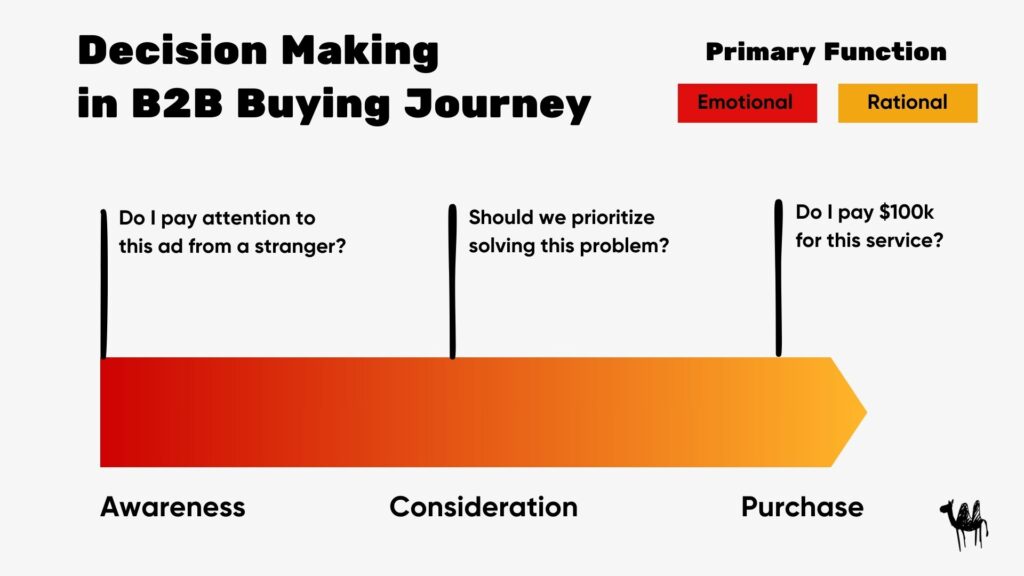
Aligning our communication with buyers’ Micro Decisions ensures our message influences them, guiding buyers to the ultimate decision: buying from our brand.
This is why B2B advertising needs to be communicated emotionally. Advertising influences buyers in the beginning of the buying journey, when they are not yet evaluating, justifying, and managing risk.
But what happens if we don’t align with how they make these Micro Decisions and make our ads too rational (like most B2B companies)?
The Outcomes of Rational vs. Emotional Advertisements
Let’s look at each of the 3 main outcomes comparing rational advertising and emotional advertising.
We’ll use everyday examples, scientifically backed research, and excerpts from our B2B communication advisor, Bobathor The Caveman, to explain.
Outcome 1: When you communicate emotionally, your ads about the problem-focused message are heard/read
What gets our attention? How does one decide what to give their attention to and when?
Well, it depends.
Sometimes we give our attention to something unintentionally. A beautiful person walks by us and smiles. We look back, staring, and… BAM! We walked straight into a pole because we weren’t paying attention (to the right thing).
Sometimes we give our attention to something intentionally. For New Year’s, we decide we’re going to pay more attention to the gym and what kinds of food we should be eating. We make the conscious and intentional decision to pay attention.
But here’s the thing.
No one is intentionally making the decision of seeking out our ads.
People may, however, intentionally make the conscious decision of booking a call with us.
Again, this is because of the difference in decision making in the buying journey (the beginning vs the end).
So if we can’t get buyers (aka strangers) to intentionally consume our ads, how do we get them to do it unintentionally?
We use basic human psychology and evolution.
Think back to our ancestors, living in caves and fighting for survival. We’ll use our buddy Bobathor The Caveman as an example. We’ll call him Bob for short.
Picture this.
Bob is taking a leisure walk in the woods on his way to the local CaveMart (Save money, survive better). The sounds of nature surround him: birds chirping, river flowing, wind in the leaves. But all of a sudden, he hears crumpling sticks and leaves nearby and immediately turns around, his heart pounding with adrenaline. Bob sees a big bad wolf ready to attack.
Let’s look at this situation through a psychological lense.
Bob is receiving lots of stimuli (the landscape, birds, river flowing) but a certain stimulus stands out in his mind (the sound of crumpling leaves). His brain makes him pay attention to it by making him feel emotions: fear and adrenaline. This is what makes him pay attention instinctively to the problem (wolf) so he would be ready to fight or flee in order to survive.
Emotions are deeply embedded in our biology and are linked to survival. Our brains are wired to pay attention to emotionally significant events because they often carry important information for our well-being. For example, fear can signal danger, while joy can indicate a beneficial situation. This evolutionary trait helps us prioritize and respond to stimuli that may impact our survival or well-being.
Whether you’re browsing through Linkedin, TV channels, or a predator infested forest, you’re bombarded with stimuli. And the best way for something to stand out and require your selective attention is emotion.
Our buddy Bobathor didn’t hear the crumpling leaves and sit down to ponder for an hour whether or not he should turn around and pay attention to the stimuli. It was instinctive, subconscious, and immediate. It was not a rational decision.
Remember Bobathor’s words of wisdom on the matter, “ME NO THINK. ME FEEL. THEN ME LOOK.”
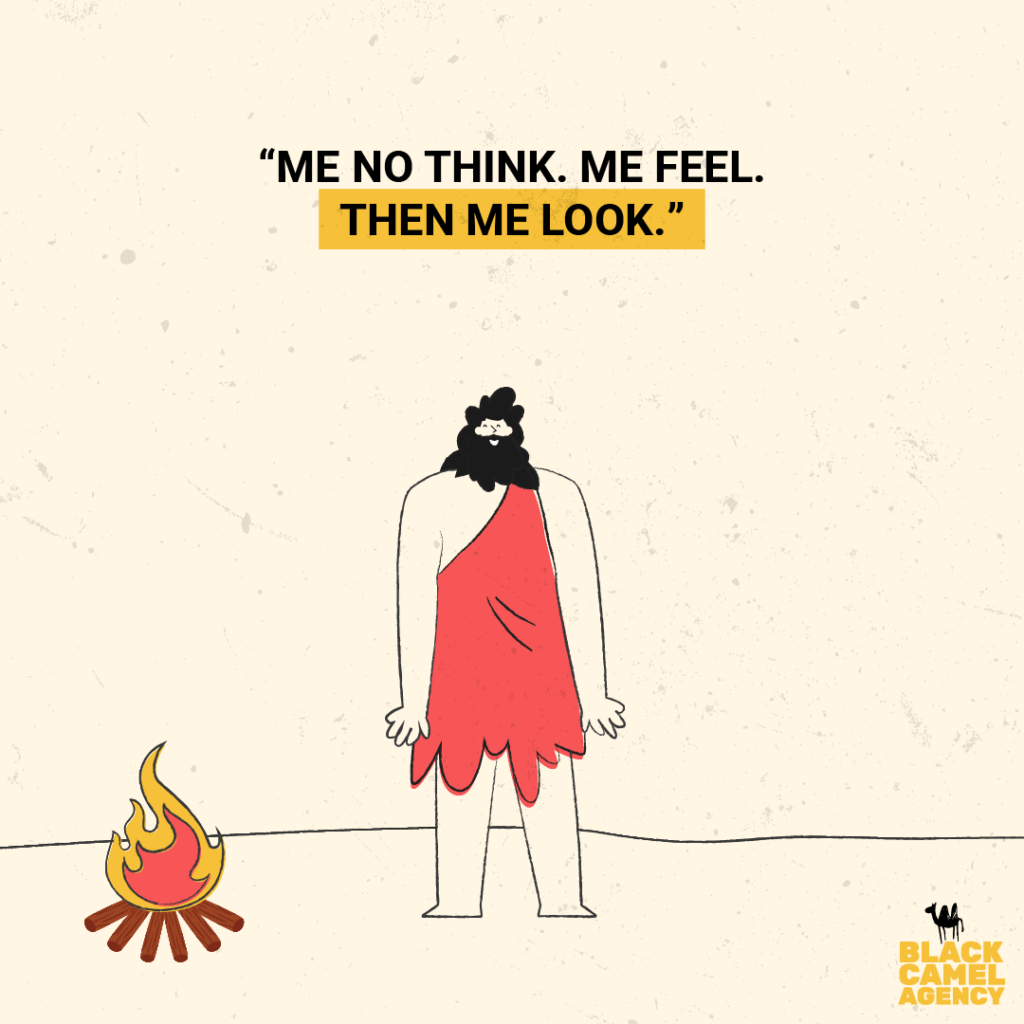
Outcome 2: When you communicate emotionally, buyers remember you as the Irreplaceable Need-To-Have solution when they are ready to buy
Why, where, and how does memory of your ad message matter?
How many times has a stranger given you directions where you enthusiastically assure them you’ve heard them, ‘Yep, yep. Turn right, then left, and left again. Great. Got it, thanks!’
Then you turn around on your way and…poof! You’ve completely forgotten how to get to your destination.
You can hear and understand a message. But if you don’t remember it when it matters, it’s completely ineffective.
Let’s say your problem-focused message is received and understood.
By ‘owning’ the problem in the buyer’s mind and connecting it to the pains they feel, you have successfully created the perception in the buyer’s mind that you are the Irreplaceable Need-To-Have solution.
This is worth a big pat on the back. Most B2B ads don’t get this far.
But here’s the thing:
Most B2B buyers are not ready at that moment to buy.
When in the buying journey does it matter to be remembered?
Remember, the buying journey consists of many Micro Decisions leading to the final purchase. Buyers need to remember you and your message at each step.
When they see your other ads, they remember the problem you solve and decide that they should listen to what else you have to say about it (because it’s valuable to them) instead of scrolling by.
When they see your marketing content, they remember that you understand their pains and care, so they decide to take the time to read all your content.
When they are researching how to solve their current pains, they remember that you help rid the pains caused by a specific problem and then decide to go to your website to learn how to solve it.
When they are shortlisting services to buy, they remember you as a solution to an important and urgent problem, deciding to put you at the top of the list.
When they are with peers from their network, they remember to mention you as the solution to the problem their peers also suffer from.
Don’t believe this is how it works? Well, imagine the opposite. Starting from the bottom of that list, go back and replace the word ‘remember’ with ‘forgot.’
Doesn’t quite work, does it?
Of course, the buying journey isn’t always as linear as we like to think with our oversimplified explanations and graphics. It’s much messier. But we use these examples to highlight that if your brand is forgotten in each of these key deciding moments, you’ve wasted ad budget on could’ve-been-buyers that never end up buying from you.
So how do emotions get your brand remembered?
Highly emotive ads are 3x more likely to be remembered than ads with a weak emotional response.
It might seem logical to think that what gets you remembered is by talking about what’s important to the buyers – their problems, what they want, ROI, etc. Although the message has a huge impact on this (a problem-focused message will be remembered more than random abstract concepts or super generic promises), communicating it emotionally has an even greater impact.
Consider your own personal life. Which do you remember more in detail?
The first time you brushed your teeth? Or your first kiss?
The day you filled out your first job application? Or the first day at your first job?
The last time you did groceries? Or the moment you proposed or were proposed to?
Damn, we’re getting old, huh. Luckily for you, those emotional experiences helped you remember so well it feels like yesterday.
Quickly think back on your childhood. Browse through a few memories.
We can say with almost 100% certainty that the memories that came to mind were moments where emotions were running high, positively or negatively. And the ones where emotions were felt most, you can remember them in vivid detail.
Emotional events are processed more deeply and remembered more so we can guide future behavior and decision-making. Bobathor needs to remember how he almost died from a wolf so he can change his future behavior to survive.
Emotions are what make us remember the ad message about the problem. Or as wise ole Bobathor would say, “ME REMEMBER WOLF. ME BUY SPEAR AT CAVEMART.”
You need B2B buyers saying, “ME REMEMBER PROBLEM. ME REMEMBER YOU. ME BUY YOUR SOLUTION.”
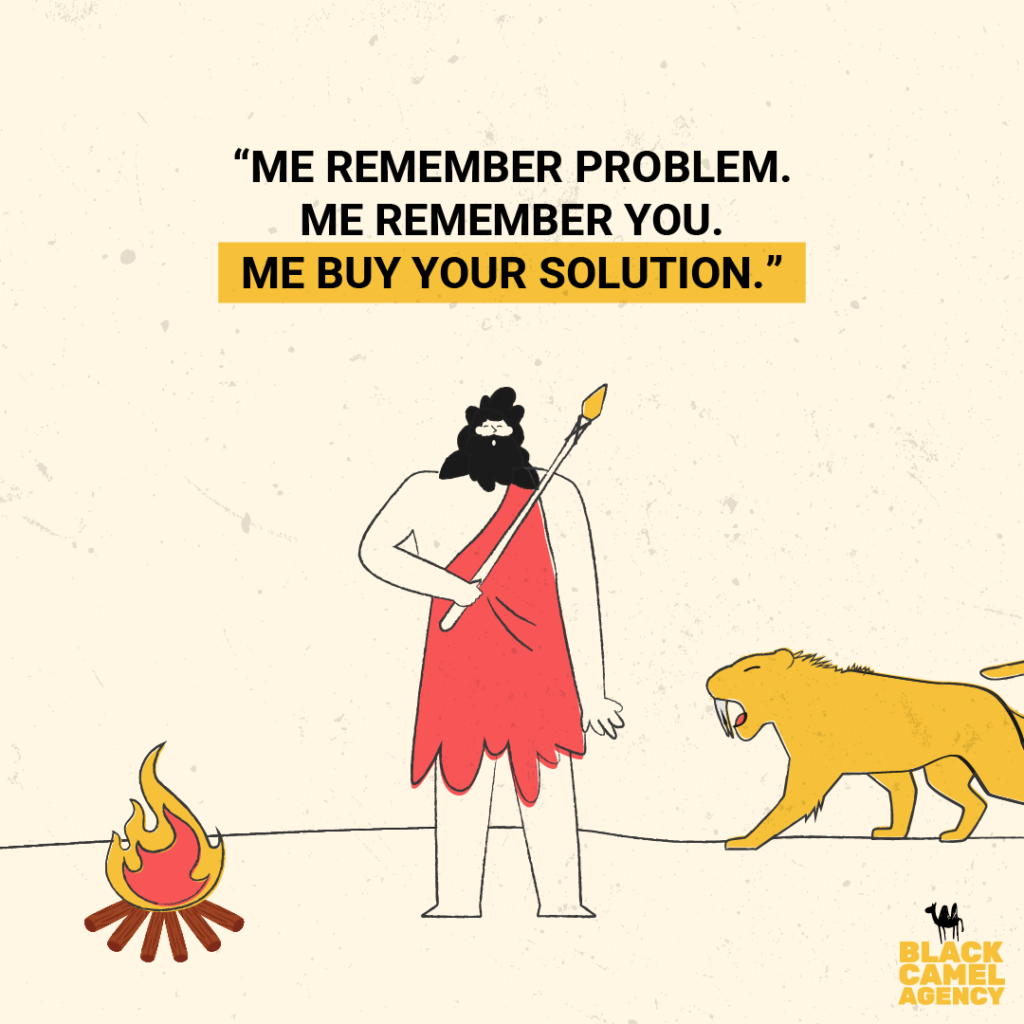
Outcome 3: When you communicate emotionally, your ad viewers share the ad with other people that suffer from the problem
Sharing an ad? What?! Bet you didn’t even think that sharing a B2B ad was something someone even did!
That’s because we’re so caught up in trying to figure out why only 0.5% of ad viewers pay attention to our boring ads in the first place that we forget that an ad could be something someone wants to share with others. An ad isn’t something people have to suffer through.
Advertising plays a big part in marketing. It’s one of the most scalable and measurable ways of acquiring new customers. You wouldn’t be reading this if it wasn’t.
But as one of our favorite marketers, Christopher Lochhead, says:
“Word of Mouth is, was, & always will be the most powerful marketing.”
Word-of-mouth generates 5x more sales than paid advertising across various industries, according to SEM Rush.
Why? It’s human. We spread word about a solution to a problem to help others, being motivated by a sense of belonging, emotional connection, social currency, etc.
The reason WOM is so effective is that it gets the right words (the problem you solve) into the right minds (the people that suffer from the problem) communicated by the right person (a trusted friend or colleague). Oh, and it’s all free.
And if you’ve read the first 3 of our articles… People buy solutions to their problems!
So how does emotion lead to ads being shared?
Can any emotion boost sharing?
Jonah Berger, author of Contagious: Why Things Catch on, explains how emotions make us share.
Berger and his team spent years analyzing the New York Times’ Most EMailed List (news articles shared by email) to understand why certain pieces of online content were shared and went viral.
“Talking to others often makes emotional experiences better. If we get promoted, telling others helps us celebrate. If we get fired, telling others helps us vent. Emotion sharing is thus a bit like social glue, maintaining and strengthening relationships.”
A simple way to sum it up, “We share when we care.”
As they hypothesized, content that was ranked as more ‘interesting’ or ‘useful’ was shared more than others. But what they didn’t expect to find was that emotion and what type of emotion had the biggest impact on the virality of the content.
When it comes to emotional communication, there are 2 dimensions to consider.
Dimension 1:
The most obvious dimension: is it positive emotion or negative emotion? Does it feel good? Or does it feel bad? But what’s less obvious is that whether the emotion we feel is positive or negative doesn’t actually affect its virality.
Dimension 2:
What does affect virality is the second dimension of emotions: is it a high-arousal emotion or low-arousal emotion?
Arousal is a state of readiness for action. It stems from our fight-or-flight nature. When we feel high-arousal emotions, we do things. When we feel low-arousal emotions, we do nothing.
Take a look at this table.
We’ll let our guest speaker, Bobathor, explain how the level of arousal affects action.
“WHEN…
ME FEEL EXCITED, ME RUN.
ME FEEL ANGRY, ME HIT.
ME SEE FUNNY THING, ME TELL TRIBE.
BUT WHEN…
ME FEEL RELAXED, ME DO NOTHING.
ME FEEL SAD, ME DO NOTHING.
AND IF ME FEEL NOTHING, ME DO NOTHING.”
When we communicate with the right emotions, buyers take action. We want B2B buyers to see our ad and say, “ME SEE AD. ME LAUGH. ME TELL NETWORK.”
If you’ve got 3 minutes, Dylan analyses this Problemotional Ad that got 400 reposts and 600 comments on Linkedin. Compare that with the 3 likes on your own Attention Repellent Ads.
To easily remember all 3 of the outcomes of emotional advertising…
- be heard
- be remembered
- be shared
… Bobathor yet again speaks his beautifully articulated words of wisdom…
“ME SEE WOLF. ME REMEMBER WOLF. ME TELL TRIBE. ALL TRIBE BUY SPEAR AT CAVEMART.”
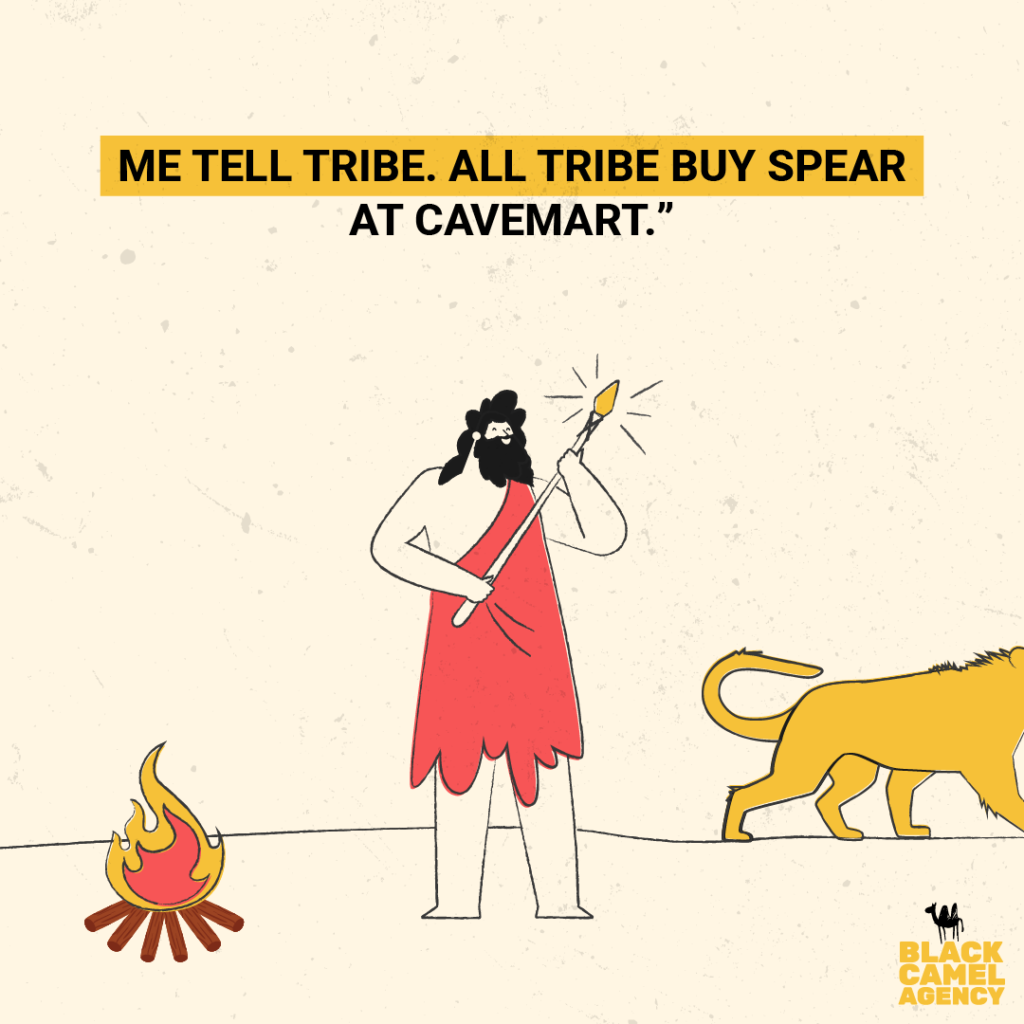
When you plan your B2B ads, always think of Bobathor.
Emotional B2B Advertising for Boring Services?
BUT WAIT A MINUTE… How can we be emotional when our B2B brand/service/industry is sooo boring?
Perhaps by now, you understand the importance of communicating in an emotional way for B2B ads. But you can’t quite visualize how it could possibly work for your B2B service. “We’re not fun! We don’t sell B2C products like beer or knitted cat hats.”
Let’s look at one of the most boring possible services to advertise: a search engine. Google’s blank interface doesn’t quite scream ‘adrenaline junkie.’ Although it’s technically not a B2B example, it is equally ‘boring’ like most B2B services.
At Google, a designer once had to justify why a certain toolbar should use the color, blue, with ‘quantitative research’. If that doesn’t sound like a typical boring B2B company, what does?
And yet, Google pulled off one of the most emotional Problemotional Ads ever created. Despite being an advertisement, it was shared and went viral.
Check this out. And try not to cry. You can also see more Problemotional video ad examples that we gathered from Linkedin here.
The problem-focused message? We all have unique and situational questions about everything in life and need them answered.
The high-arousal emotion? Awe.
But Google isn’t the only one. We’ve got a whole list of other boring B2B services that communicate emotionally in the beginning of the buying journey.
In our YouTube playlist, we analyze Problemotional Ads from brands like…
Salesforce, Workdesk, Slack, Winn AI, Teamwork, Zendesk.
Challenge: Click through, watch the ads, and TRY not to laugh.
